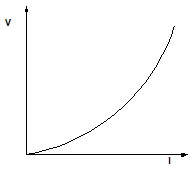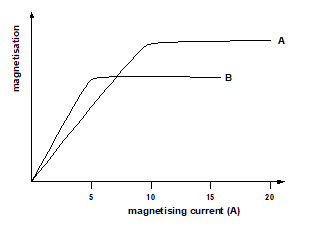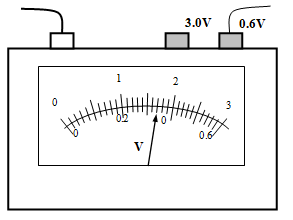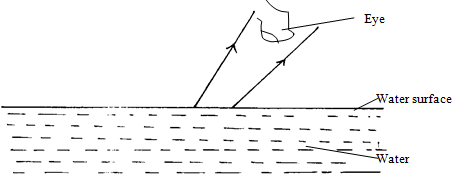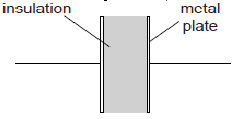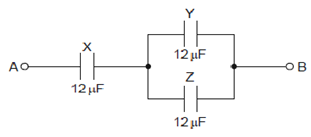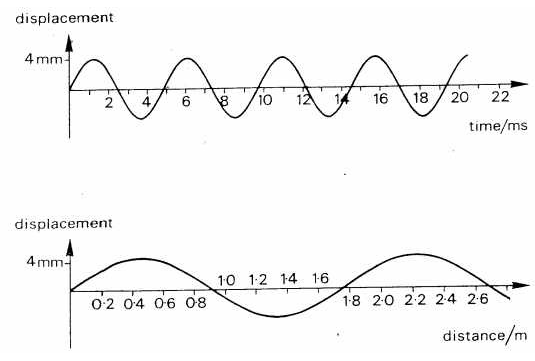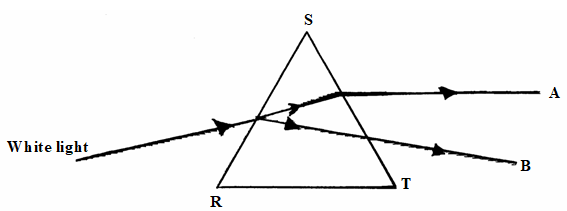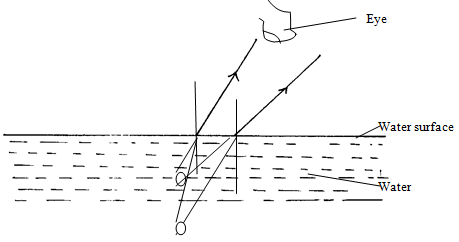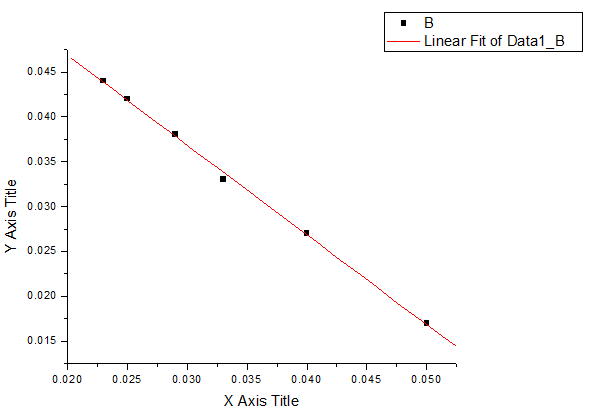Instructions to candidates
- This paper consists of two sections A and B.
- Answer all the questions in the two sections in the spaces provided after each question
- All working must be clearly shown.
- Electronic calculators, mathematical tables may be used.
- All numerical answers should be expressed in the decimal notations.
SECTION A (25 Marks)
Answer ALL questions in this section.
- Figure 1 shows the V-I characteristic curve of a torch bulb.
Fig 1
Explain the shape of the graph. (2 marks) - The size of the pinhole camera is increased. State and explain what happens to the image.
(1 mark) - Define the term sensitivity (1 mark)
- Why is concave mirrors used as a saloon mirror? (1 mark)
- Figure 2 shows a graph of magnetisation against magnetising current for two materials A and B.
Fig. 2- State with a reason, the material which is more suitable for use in a transformer to concentrate the magnetic fields. (2 marks)
- Determine the current required to obtain saturation for the material which is suitable for making a permanent magnet. (1 mark)
- A beaker of height 10 cm is filled with water. An optical pin which is at the bottom of the beaker is then viewed from the top of the beaker. How far does the pin appear from the surface, if the refractive index of water is 4/3 (2 marks)
- An electric heater takes 4 minutes to heat some water to boiling point. How long would it take if the current flowing through it is doubled? (2 marks)
-
- State Ohm’s law (1mark)
- The figure 3 below shows part of the scale of a voltmeter, which is being used in an experiment to measure potential difference across a resistor.
Fig.3- State the accuracy of the upper and the lower scales of the voltmeter. (2 marks)
- Record the reading shown by the lower scale of the voltmeter. (1 mark)
- The figure 4 shows region of electromagnetic spectrum.
Fig.4
Name the region that representsand give one use of each. (4marks)- Ultraviolet
- Infrared
- X- ray
- Radio wave
- State one advantage of optical fibre cable over conventional copper cables as used in telecommunication. (1 mark)
- Fig 5. below shows the paths of two rays which enter the eye from a small object immersed in water.
Draw rayson the diagram to show a possible position of the object and its actual position. (2marks) - State two conditions necessary for total internal reflection to occur. (2marks)
SECTION B(55 Marks)
Answer ALL questions in this section.
-
-
- Define capacitance. (1 mark)
- A capacitor is made of two metal plates, insulated from one another, as shown in the Fig 6.
Fig. 6
Explain why the capacitor is said to store energy but not charge. (2 marks)
- Three uncharged capacitor X, Y and Z, each of the capacitance 12 microfarads, are connected as shown in Fig 7 below
Fig. 7
A potential difference of 9.0V is applied between points A and B. Calculate the combined capacitance of the capacitors X,Y and Z. (3 marks) - Explain why, when the potential difference of 9.0V is applied, the charge on one plate of capacitor X is 72 microcoulombs. (2 marks)
- Determine ;
- the potential difference across capacitor X, (2 marks)
- the charge on one plate of capacitor Y. (2 marks)
-
-
- A wire was connected to a battery and it was found that the energy converted to heat was 30J when 20 coulombs of charge flowed through the wire in 5 seconds.
Calculate;- the p.d between the ends of the wire. (2marks)
- the current flowing through the wire. (2marks)
- the resistance of the wire. (2marks)
- the average power development in the wire. (2marks)
- The graph below shows results obtained in an experiment to determine the e.m.f.(E) and the internal resistance, r, of a cell.
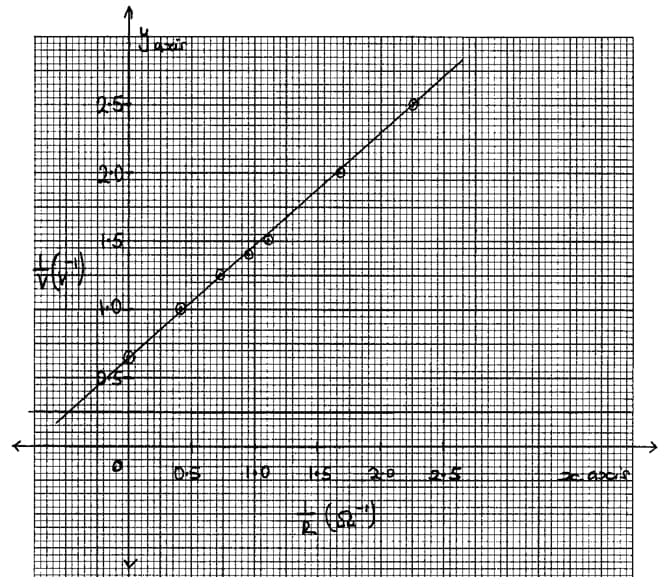
Given that the equation of the graph is E/V = r/R + 1
Use the graph to determine the values of:-- E (2marks)
- r (3marks)
- A wire was connected to a battery and it was found that the energy converted to heat was 30J when 20 coulombs of charge flowed through the wire in 5 seconds.
-
- The figure 8 below shows two graphs which refer to the same wave.
Fig. 8- Calculate the speed of the wave. (4marks)
- Distinguish between progressive and stationary waves. (2marks)
- Figure 9 below shows a stationary wave on a string stretched between two points A and F which are a distance L apart.
Fig. 9- Describe the oscillations of the points B, C, D and E.Compare these oscillations in terms of their relative phases and amplitudes. (3marks)
- What is the wavelength in terms of L. (1mark)
- The figure 8 below shows two graphs which refer to the same wave.
-
- State the characteristics of images formed by a pinhole camera. (2marks)
- What is the effects on the image when the camera is elongated? (2mark)
- The figure 10 below shows how a white light behaves when it is incident on a equilateral glass prism.
Explain why it split into different colours between A and B. (3 marks) - Suppose the white light is incident on the face SR normally, State and explain the observation. (3 marks)
-
- Define the term principal focus in relation to a thin convex lens (2marks)
- Distinguish between a real and a virtual image. (2marks)
- The Fig.11 below shows an arrangement of lenses, Lo and Le used in a compound microscope Fo and Fe are principal foci of Lo and Le respectively.
Figure 11
Draw the rays to show how the final image is formed in the microscope (3marks) - The table below shows the object distance, U and the corresponding image distance, V for an object placed
U (cm) 20 25 30 35 40 45 V (cm) 60.0 37.5 30.0 26.3 24.0 22.5 1/u (cm−1) 1/v (cm−1) - Complete the table and plot a graph of 1/v against 1/u (7marks)
- Determine the focallength of the lens. (2marks)

MARKING SCHEME
- Figure 1 shows the V-I characteristic curve of a torch bulb.
Explain the shape of the graph. (2 marks)- Resistance increases with temperature due to heating effect of current
- The size of the pinhole camera is increased. State and explain what happens to the image. (1 mark)
- Blurred images/too much light entering through hole
- Define the term sensitivity (1 mark)
- Ability to measure small changes using an instrument
- Why is concave mirrors used as a saloon mirror? (1 mark)
- A large erect image
- Figure 2 shows a graph of magnetisation against magnetising current for two materials A and B.
- State with a reason, the material which is more suitable for use in a transformer to concentrate the magnetic fields. (2 marks)
- B
Easily magnetized and easily demagnetised
- B
- Determine the current required to obtain saturation for the material which is suitable for making a permanent magnet. (1 mark)
- 10A
- State with a reason, the material which is more suitable for use in a transformer to concentrate the magnetic fields. (2 marks)
- A beaker of height 10 cm is filled with water. An optical pin which is at the bottom of the beaker is then viewed from the top of the beaker. How far does the pin appear from the surface, if the refractive index of water is 4/3 (2 marks)
n = real depth
apparent depth
4/3 = 10/x
x=7.5 - An electric heater takes 4 minutes to heat some water to boiling point. How long would it take if the current flowing through it is doubled? (2 marks)
I = 240IV
2I = 2E
240V
E = VIt time will reduce by half -
- State Ohm’s law (1 mark)
- Current through a conductor is directly proportional to p.d across its ends provided temperature remains contant
- The figure 3 below shows part of the scale of a voltmeter, which is being used in an experiment to measure potential difference across a resistor.
- State the accuracy of the upper and the lower scales of the voltmeter. (2 marks)
- Upper scale = 0.1V
- Lower scale =0.2V
- Record the reading shown by the lower scale of the voltmeter. (1 mark)
- 0.34V
- State the accuracy of the upper and the lower scales of the voltmeter. (2 marks)
- State Ohm’s law (1 mark)
- The figure 4 shows region of electromagnetic spectrum.
Name the region that represents and give one use of each. (4 marks)- Ultraviolet B, Vitamin D,Kill Bacteria
- Infrared C, cooking warming green house
- X- ray A,radiology,radiography crystallography,radiotherapy
- Radio wave F,E,communication
- State one advantage of optical fibre cable over conventional copper cables as used in telecommunication. (1 mark)
- Fig 5. below shows the paths of two rays which enter the eye from a small object immersed in water.
Draw rays on the diagram to show a possible position of the object and its actual position. (2 marks)
Lighter and thinner - State two conditions necessary for total internal reflection to occur. (2 marks
- Light must be travelling optically denser to optically less dense medium
- c < i
SECTION B (55 Marks)
Answer ALL questions in this section.
-
-
- Define capacitance. (1 mark)
- Ratio of charge to its potential charge per unit potential difference
- A capacitor is made of two metal plates, insulated from one another, as shown in the Fig 6.
Explain why the capacitor is said to store energy but not charge. (2 marks)- If one plate of a capacitor has 1 coulomb of charge stored on it, the other plate will have -1 coulomb, making the total charge (added up across both plates) zero.
- Its two plates hold opposite charges and the separation between them creates an electric field. That's why a capacitor stores energy
- Define capacitance. (1 mark)
- Three uncharged capacitor X, Y and Z, each of the capacitance 12 microfarads, are connected as shown in Fig 7 below
A potential difference of 9.0V is applied between points A and B. Calculate the combined capacitance of the capacitors X,Y and Z. (3 marks)
parallel =12+12=24
24 and 12 in series
Product = 24 x12
sum 36
= 8 microfarads - Explain why, when the potential difference of 9.0V is applied, the charge on one plate of capacitor X is 72 microcoulombs. (2 marks)
Q = CV
= 8 x 9
=72 microcoulombs - Determine ;
- the potential difference across capacitor X, (2 marks)
V= Q/C
= 72/12
= 6V - the charge on one plate of capacitor Y. (2 marks)
Q = CV
= 12 x 3
= 36 microcoulombs
- the potential difference across capacitor X, (2 marks)
-
-
- A wire was connected to a battery and it was found that the energy converted to heat was 30J when 20 coulombs of charge flowed through the wire in 5 seconds.
Calculate;- the p.d between the ends of the wire. (2 marks)
QV
30 =20V
V = 1.5 V - the current flowing through the wire. (2 marks)
H = VIt
30 = I x 1.5 x 5
I = 4A - the resistance of the wire. (2 marks)
H= I2Rt
= V2t/R
R = 0.375 ohms - the average power development in the wire. (2 marks)
P = V2R
Or = VI
4 x 1.5 = 6 watts
- the p.d between the ends of the wire. (2 marks)
- The graph below shows results obtained in an experiment to determine the e.m.f. (E) and the internal resistance, r, of a cell.
- Given that the equation of the graph is E/V = r/R + 1
Use the graph to determine the values of:-- E (2 marks)
1/V = r/ER + 1/E
E = 1.538V - r (3 marks)
r/E = gradients = 0.822
r=1.265ohms
- E (2 marks)
- A wire was connected to a battery and it was found that the energy converted to heat was 30J when 20 coulombs of charge flowed through the wire in 5 seconds.
-
- The figure 8 below shows two graphs which refer to the same wave.
- Calculate the speed of the wave. (4 marks)
T = 5 x 10-3
λ = 1.8 m
speed = 1.8 /5 x 10-3
speed = 360 m/s - Distinguish between progressive and stationary waves. (2 marks)
- Progressive waves move continually away from the source while stationary waves is formed by two progressive waves travelling in different direction
- Calculate the speed of the wave. (4 marks)
- Figure 9 below shows a stationary wave on a string stretched between two points A and F which are a distance L apart.
- Describe the oscillations of the points B, C, D and E. Compare these oscillations in terms of their relative phases and amplitudes. (3 marks)
- C and D are in phase with different amplitudes
- Particle in B are out phase and have zero amplitude
- C and E have same amplitudes
- What is the wavelength in terms of L. (1 mark)
- λ = 0.5L
- Describe the oscillations of the points B, C, D and E. Compare these oscillations in terms of their relative phases and amplitudes. (3 marks)
- The figure 8 below shows two graphs which refer to the same wave.
-
- State the characteristics of images formed by a pinhole camera. (2 marks)
- diminished
- real
- inverted
- What is the effects on the image when the camera is elongated ? (2 mark)
- the size of the image increases.
- The figure 10 below shows how a white light behaves when it is incident on a equilateral glass prism.
Explain why it split into different colours between A and B. (2 marks)- Each colour has a different refractive indexin glass due to different velocities
- Suppose the white light is incident on the face SR normally, State and explain the observation. (3 marks)
- white light passes undeviated through SR
- there is total internal reflexion on RT
- white light passes through ST undeviated
- State the characteristics of images formed by a pinhole camera. (2 marks)
-
- Define the term principal focus in relation to a thin convex lens (2 marks)
- Is a point on the principal axis to which paraxial rays converge after refaction
- Distinguish between a real and a virtual image. (2 marks)
- Real images are focused on screen while virtual images cannot
- Real images are formed actual intersection while virtual images by appent intersection
- The Fig.11 below shows an arrangement of lenses, Lo and Le used in a compound microscope Fo and Fe are principal foci of Lo and Le respectively.
Draw the rays to show how the final image is formed in the microscope (3 marks) - The table below shows the object distance, U and the corresponding image distance, V for an object placed
- Complete the table and plot a graph of against (7 marks)
U (cm) 20 25 30 35 40 45 V (cm) 60.0 37.5 30.0 26.3 24.0 22.5 1/u (cm−1) 0.050 0.040 0.033 0.029 0.025 0.023 1/v (cm−1) 0.017 0.027 0.033 0.038 0.042 0.044 - Determine the focal length of the lens. (2 marks)
f= (0.067)-1
f= 14.93 cm
- Complete the table and plot a graph of against (7 marks)
- Define the term principal focus in relation to a thin convex lens (2 marks)
Download Physics Paper 2 Questions and Answers - Momaliche Post Mock 2020 Exam.
Tap Here to Download for 50/-
Get on WhatsApp for 50/-
Why download?
- ✔ To read offline at any time.
- ✔ To Print at your convenience
- ✔ Share Easily with Friends / Students

